You might have chatted to other farmers about finance and wondered why they got a different rate from you even though you have many similarities between businesses. Or maybe you’re getting offered different loan terms between lenders even though you’re giving them the same info. It’s something we see regularly, and fortunately, we’re able to get excellent insights into why these inconsistencies happen through our relationship with lenders across Australia.
So why are lenders inconsistent? There are many factors that they look at; bank revenue and profitability KPIs, your equity in the farm, capacity to pay, management strategies and systems in place to ensure the business’s profitability.
Frustratingly, some inconsistency on the interest rate and whether you get a loan or not comes down to the risk appetite of the individual banker you are dealing with. A busy banker may assess your application simply on their view, it has been said that 20 per cent of Agribusiness Bankers write 100 percent of their Banks Business so if you happen to meet a Banker who is not part of the 20 percent you are likely to get a poor outcome. There are over 1000 Agribusiness Bankers across Australia in different organisations so you need to avoid the 800 that will likely give you a result that will be less than desirable.
Despite these influences, there are things you can do to place your farming business in the best possible place to get a loan at a competitive interest rate with the right structure.
- Presentation is essential: A professional presentation with the bank is critical for a successful application. This includes submitting a well-thought-out and researched business plan, forecast, cash flows and that you operate with sound management and systems.
- Get a second opinion: Bankers have different KPIs and profit goals to achieve, so if you get a result from one, visit others for a second opinion.
- Check the market: As a rule of thumb, we suggest you test the market every three years to see if you can get a better rate or terms on your loan.
It’s also a good idea to take a long-term view of your farm and appreciate that it will change over time, so loan terms and rates will vary with those changes. Business banking is a people game, so you need to make sure you get the right advice when dealing with your local lender.
For further information, please speak to your SproutAg Advisor.










